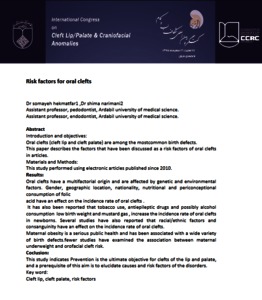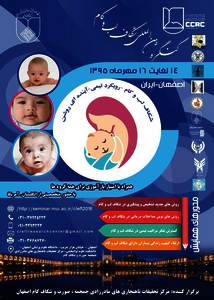حکمت فر, سمیه ، نریمانی, شیما (1395) ریسک فاکتورهای شکاف دهانی. در: international congress on cleft lip/palate & craniofacial anomaliesess, Oct 5-7 , 2016, Esfahan - Iran.
متن کامل
![[img]](https://eprints.arums.ac.ir/7910/1.hassmallThumbnailVersion/2016-10-09_0-06-02.png)
|
متنی
78kB | |
![[img]](https://eprints.arums.ac.ir/7910/2.hassmallThumbnailVersion/poster_1.jpg)
|
تصویر
117kB |
آدرس اینترنتی رسمی : http://seminar.mui.ac.ir/cleft2016/
خلاصه فارسی
مقدمه و اهداف : شکاف دهانی (شکاف لب و شکاف کام) یکی از شایعترین نقایص حین تولد است. این مقاله به بررسی ریسک فاکتورهای مرتبط با شکاف های دهانی می پردازد. روش اجرا: این مطالعه با مروز مقالات منتشر شده از سال 2010 تا کنون انجام شده است. یافته ها: شکاف های دهانی منشا چند عاملی دارد و تحت تاثیر فاکتورهای ژنتیک و محیطی می باشد.جنسیت، موقعیت جغرافیایی، میزان مصرف اسید فولیک، شیوع شکاف های دهانی را متاثر می سازد.همچنین مطالعات نشان داده است که مصرف تنباکو، داروهای ضد صرع ، الکل ، وزن کم حین تولد و میزان شیوع شکاف های دهانی را افزایش می دهد.مطالعات متعددی گزارش کرده اند که عوامل نژادی/ قومی و خویشاوندی در میزان بروز شکاف های دهانی دارای اثر هستند.اضافه وزن مادر یک مسئله بهداشتی جدی است و با نقایص مادرزادی مختلفی مرتبط می باشد.چندین مطالعه رابطه بین وزن کم مادر و شکاف دهانی را بررسی کرده اند. نتیجه گیری: این مطالعه نشان داد که پیشگیری یک هدف بسیار مهم در ارتباط با شکاف لب و شکاف کام است و پیش نیاز نیل به این هدف روشن شدن عوامل و ریسک فاکتورهای این بیماری می باشد
عنوان انگليسی
Risk factors for oral cleftsمقدمه و اهداف : شکاف دهانی (شکاف لب و شکاف کام) یکی از شایعترین نقایص حین تولد است. این مقاله به بررسی ریسک فاکتورهای مرتبط با شکاف های دهانی می پردازد. روش اجرا: این مطالعه با مروز مقالات منتشر شده از سال 2010 تا کنون انجام شده است. یافته ها: شکاف های دهانی منشا چند عاملی دارد و تحت تاثیر فاکتورهای ژنتیک و محیطی می باشد.جنسیت، موقعیت جغرافیایی، میزان مصرف اسید فولیک، شیوع شکاف های دهانی را متاثر می سازد.همچنین مطالعات نشان داده است که مصرف تنباکو، داروهای ضد صرع ، الکل ، وزن کم حین تولد و میزان شیوع شکاف های دهانی را افزایش می دهد.مطالعات متعددی گزارش کرده اند که عوامل نژادی/ قومی و خویشاوندی در میزان بروز شکاف های دهانی دارای اثر هستند.اضافه وزن مادر یک مسئله بهداشتی جدی است و با نقایص مادرزادی مختلفی مرتبط می باشد.چندین مطالعه رابطه بین وزن کم مادر و شکاف دهانی را بررسی کرده اند. نتیجه گیری: این مطالعه نشان داد که پیشگیری یک هدف بسیار مهم در ارتباط با شکاف لب و شکاف کام است و پیش نیاز نیل به این هدف روشن شدن عوامل و ریسک فاکتورهای این بیماری می باشد
خلاصه انگلیسی
Introduction and objectives: Oral clefts (cleft lip and cleft palate) are among the most common birth defects. An oral cleft is a complex developmental trait initiated in the first trimester of pregnancy. This paper describes the factors that have been discussed as a risk factors of oral clefts in articles. Materials and Methods: This study performed using electronic articles published since 2000. Results: Oral clefts have a multifactorial origin and are affected by genetic and environmental factors. The causal single nucleotide polymorphism (SNP) signature profile underlying the risk of familial Oral clefts still remains unknown but three common polymorphisms of the TNFA gene have been investigated with susceptibility to the CL/P. Gender, geographic location, nationality, nutrition have an effect on the incidence rate of oral clefts. The parents aged 40 or older had an increased risk of generating a child with CP and mothers aged 35-39 years were more likely to produce a child with CP. Mothers aged 40 or older had an increased risk of generating a child with CL and/or P. There is no evidence was found associating younger parents with increased risk to the occurrence of clefts. The greater the number of pregnancies, greater the risk of a woman having a child with cleft perhaps because an excessive number of abortions could lead to damage or dysfunction in the female reproductive tract. The association of oral clefts and the use of certain drugs during pregnancy have been suggested over the past decades. Medications such as anticonvulsants, benzodiazepines, and corticosteroids have been investigated. However, the association of these drugs with the occurrence of oral clefts is still inconclusive. The use of folic acid and vitamin supplements during pregnancy has been inversely related to the occurrence of oral clefts, but this relation still has consistency limitations and the mechanism of how this protective effect occurs is still unknown. Low intake of micronutrient-dense foods (e.g., vegetables) is also positively associated with oral cleft risk. A positive association between alcohol consumption during pregnancy and occurrence of oral clefts has been shown in several studies, but not in all. This inconsistency in the results may be due to the need of excessive consumption of alcohol for the expression of the anomaly, which is uncommon in pregnancy. Maternal exposure to tobacco smoke has been reported as the strongest risk factor for oral clefts. Maternal passive smoking exposure results the increase in the risk of orofacial clefts, similar to the magnitude of risk reported for active smoking. There is a significant association between maternal education and the risk of oral clefts, and that CL/P case mothers had lower educational levels. It has also been reported that maternal contact with chemical agents in the first trimester of pregnancy, low birth weight and mustard gas , increase the incidence rate of oral clefts in newborns. Maternal obesity is a serious public health and has been associated with a wide variety of birth defects. fewer studies have examined the association between maternal underweight and orofacial cleft risk. Several studies have also reported that racial/ethnic factors and consanguinity have an effect on the incidence rate of oral clefts. Coclusion: This study indicates Prevention is the ultimate objective for clefts of the lip and palate, and a prerequisite of this aim is to elucidate causes and risk factors of the disorders.
| نوع سند : | موضوع کنفرانس یا کارگاه (سخنرانی ) |
|---|---|
| زبان سند : | انگلیسی |
| نویسنده اول : | سمیه حکمت فر |
| نویسنده : | شیما نریمانی |
| کلیدواژه ها (فارسی): | شکاف لب، شکاف کام ، ریسک فاکتور |
| کلیدواژه ها (انگلیسی): | Cleft lip, cleft palate, risk factors |
| موضوعات : | WU دندانپزشکی .جراحی دهان > WU.18 آموزش دندانپزشکی، جراحی دهان |
| بخش های دانشگاهی : | دانشکده دندانپزشکی > گروه دندانپزشکی کودکان |
| کد شناسایی : | 7910 |
| ارائه شده توسط : | دکتر سمیه حکمت فر |
| ارائه شده در تاریخ : | 11 آبان 1395 08:11 |
| آخرین تغییر : | 26 فروردین 1397 12:51 |
فقط پرسنل کتابخانه صفحه کنترل اسناد





